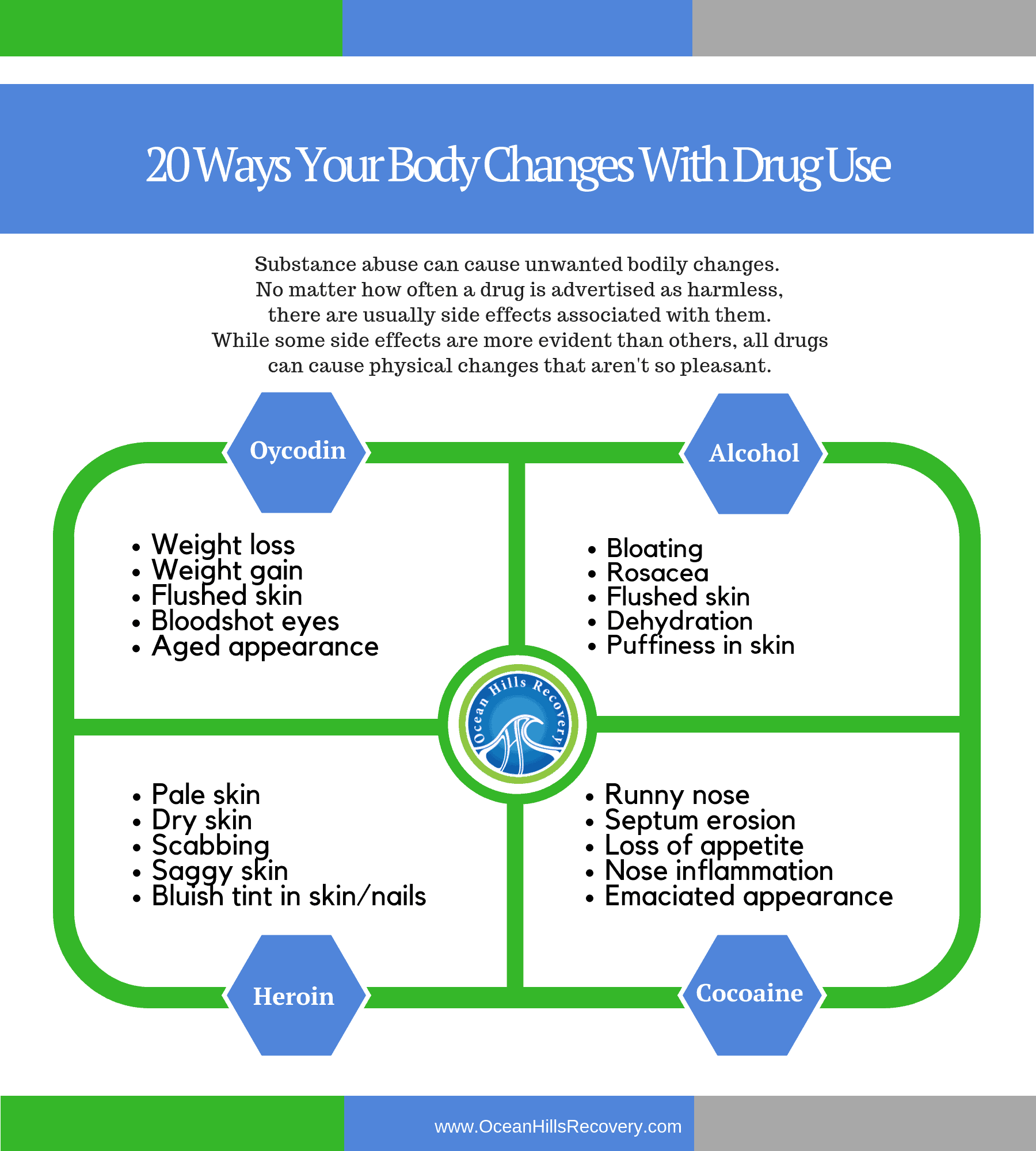Facial Changes with Substance Abuse
Millions of Americans are addicted to drugs or alcohol. Substance abuse can cost people everything – from friends to family, homes, and their livelihood. The impact of addiction is even more evident on the faces of addicts themselves.
The catastrophic result of substance abuse is physically visible and can range from decayed teeth to skin scabs. Illicit drugs come with different side effects, but one thing is common: they all have a different face!
The Different Faces of Substance Abuse
Continuously abusing drugs or alcohol is damaging and can result in many debilitating physical conditions. Addicts make drugs the most essential thing in their lives, leading them to pursue them at all costs, thereby neglecting their health and bodies. When self-neglect becomes a usual way of life, the consequence will remain etched on a person’s skin for years to come. Let’s take a look at how different drugs can change the looks of people with an addiction problem.
Meth
Meth is often regarded as one of the most visibly destructive drugs. People who are addicted to Methamphetamine are prone to weight loss, teeth decay, facial sores, and accelerated aging. The drug has a drying effect on the skin, which causes itching.
Opioids
Opioids like heroin and OxyContin can cause flushing and a rash of red bumps all over the body. When these drugs are abused, they cause weight loss, skin abscesses, cellulite, and scabs. The scabs are caused by picking the skin due to dryness. Heroin addicts lose their skin radiance and tend to look dull and wasted. This is because it lowers the body’s blood pressure and heart rate; as the blood supply is reduced, the skin and nails appear bluish and flushed.
Cocaine
The most significant effect of cocaine abuse is the inflamed nose that many users have. It is common to see people addicted to cocaine with reddish noses that appear to be inflamed all the time. Cocaine abuse can result in a significant loss of appetite and severe malnutrition and weight loss.
Oxycodone
This is a Schedule II drug and has both psychological and physical side effects. Mainly, oxycodone causes bloodshot eyes, which make users look tired and drowsy. It also makes the skin look flushed and can cause weight gain because users tend to have an inconsistent appetite.
Alcohol
For some people, this is harmless, but for others, it can become a habit that affects their health and alters their appearance. Alcohol dehydrates the body and leaves the skin looking dry. This habit can lead to a condition called rosacea, a skin disorder characterized by frequent flushing. As alcohol is consumed, it opens up blood vessels, causing bloating and redness. Over time, this will cause the face to become disfigured. However, when alcohol abuse stops, the body will naturally correct itself.
Fentanyl
Fentanyl, a powerful synthetic opioid, can cause significant changes to a person’s physical appearance over time. Chronic fentanyl use often leads to severe weight loss, giving the face a sunken, hollow look. The skin may appear pale, grayish, or unhealthy due to poor circulation and reduced oxygenation caused by the drug’s impact on the heart and lungs. Users may develop facial sores or scabs from frequent skin picking, a side effect linked to opioid-induced itching and agitation. Dehydration from fentanyl abuse can also make the skin dry and dull, further aging the appearance prematurely. Over time, these visible effects can make someone look far older than their actual age and reflect the serious toll fentanyl takes on overall health.
Call Ocean Hills Recovery Today
If you are ready to take the first step toward lasting recovery and a brighter future, Ocean Hills Recovery is here to support you. Our team of compassionate professionals will guide you through every stage of the healing process with the care and expertise you deserve. Do not wait to reclaim your health, your hope, and your life. Contact Ocean Hills Recovery today to speak with our admissions team and discover how we can help you begin your recovery with strength and confidence. Your new beginning starts with a single call—reach out now.
FAQs
How does methamphetamine use change a person’s appearance?
Meth use often leads to severe physical deterioration, including dramatic weight loss, tooth decay (“meth mouth”), facial sores, and accelerated aging. The drug dries out the skin, causing intense itching and frequent skin picking.
What visible effects can opioid abuse cause?
Opioid abuse can lead to flushed skin, red bumps, abscesses, scabs from skin picking, and significant weight loss. Long-term use lowers blood pressure and heart rate, which reduces blood flow and gives the skin and nails a bluish, unhealthy appearance.
How does cocaine abuse affect a person’s physical appearance?
Cocaine abuse often causes chronic inflammation of the nose, resulting in redness and swelling. Users also experience reduced appetite, severe malnutrition, and noticeable weight loss, all of which can drastically alter their appearance.
What are the physical signs of oxycodone abuse?
Oxycodone abuse can cause bloodshot eyes, flushed skin, and fluctuating weight due to inconsistent eating patterns. These physical signs make individuals appear tired, drowsy, and unhealthy over time.
How does alcohol abuse impact the way someone looks?
Alcohol abuse leads to dehydration, making the skin dry and lifeless. It can also cause rosacea, a condition that results in persistent facial redness and bloating. Long-term alcohol use can cause permanent facial disfigurement if not addressed.
















